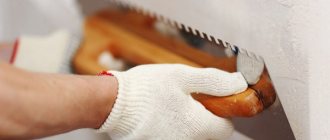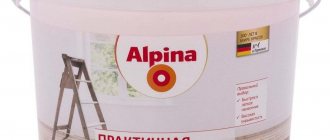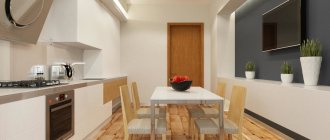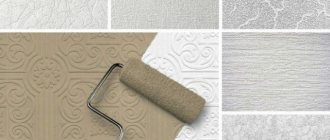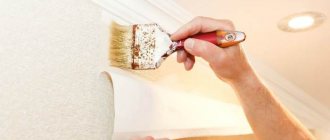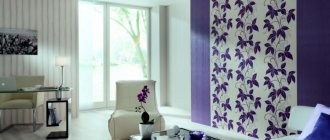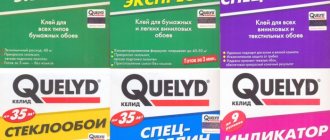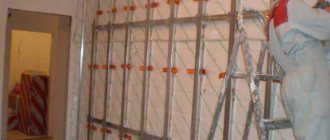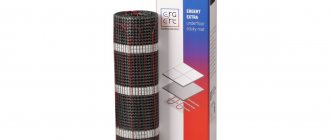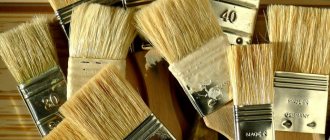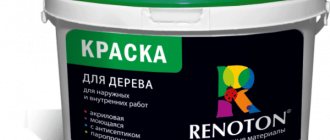When planning a renovation, many people wonder at what temperature they can glue different wallpapers in an unheated room.
Such work can be carried out at any time, subject to the following main conditions:
- absence of drafts;
- The suitable temperature for wallpapering is +23 degrees (+/- 3 divisions).
If necessary, suitable temperature conditions can be created using a radiator.
What time of year is best to glue?
The time of year does not have any influence on the quality of gluing trellises. The main thing is that there are no drafts in the room, otherwise the wallpaper will fall off. Despite this, in winter it is more difficult to glue the panels near the battery. They dry out quickly, causing them to deteriorate. If the repair doesn’t work, then it’s better to wait until spring. With the right approach to performing work, such consequences can be avoided. For this it is important:
- wrap batteries and pipes with fabric that absorbs water well;
- this rag is soaked immediately before gluing the strip;
- Soak the prepared canvas well with glue;
- the rag is periodically moistened as it dries;
- Wallpaper near and behind the battery can be moistened with water from a spray bottle.
Using similar actions, the wallpaper will not quickly dry out and shrink.
Advantages and disadvantages
Of course, any job has its pros and cons. And our case is no exception. Let's take a closer look at both the positive and negative aspects of this approach.
The advantages include such a factor as the absence of significant daily temperature changes, as well as drafts inside the apartment, since all windows, as a rule, are closed, and the temperature, thanks to heating, remains at approximately the same level. All this affects the fact that the likelihood of a better quality repair result increases significantly.
At the same time, you need to understand that certain problems can be created by the fact that the air humidity may be somewhat excessive. At the same time, constant heating, especially in cases where the room is really warm in winter, can, to a certain extent, eliminate this disadvantage.
Remember! In any case, in order to thoroughly dry the work surface, which, in turn, resists the appearance and spread of fungus and mold, it is enough to use a special construction hair dryer.
Be that as it may, the only significant disadvantage of winter wallpapering is that in such cases the wallpaper often dries unevenly on different parts of the walls. This happens because in places that are located close to heating radiators, the temperature is always higher than the average in the room. As a rule, you can deal with such a problem by using PVA glue, which is familiar to us all. This adhesive composition is very affordable, and its main advantage in our case is that it is much less susceptible to temperature changes.
How to glue wallpaper in the cold season
Experts do not recommend starting construction if the room is cold. They consider it correct to glue trellises in the summer or spring, even if the room does not have central heating. In a house heated by the sun's rays, the necessary temperature is maintained for the walls to dry properly.
Gluing strips of canvas in autumn or winter can be done without problems if repair work is carried out in heated rooms. To carry out work in an unheated room, you must follow some rules.
It is unacceptable to paste over walls in a cold room. To solve the problem, it is worth heating it using portable heating devices. In order for the glue to dry evenly on drywall or concrete, you need to maintain the required temperature and monitor the microclimate in the house.
If there is heating in the apartment, then you can carry out pasting at any convenient time. Certain troubles can arise due to high air humidity. To check this parameter, you should tape a piece of polyethylene to the wall overnight. If no condensation is detected on the material in the morning, then work can begin. Otherwise, preliminary drying of the room will be required.
You can reduce the humidity percentage to the desired value using a special device or a conventional electric heater.
Winter
From an economical point of view, the winter months are the best for alterations. Kirill Aksenov believes that this is the most obvious advantage of repairs in the cold season. Masters are not so busy, prices for their services are slightly reduced, companies offer discounts and bonuses. Sellers of building materials are trying in every possible way to attract buyers: saving money is obvious.
Problems may arise with the transportation and storage of water-based materials, and coordination of disconnecting risers to replace radiators.
Kirill Aksenov
As for thermal insulation, it is better to carry out work in winter. When it's cold outside, violations in the heat-insulating circuit are detected immediately. In summer you may not notice them.
Rules for successful pasting
To understand at what temperature to glue non-woven wallpaper, you should pay attention to the following advice from experts:
- the air temperature in the room should be from 10 to 25 degrees C. In this temperature range, the adhesive base of the canvas dries evenly. It is important that the optimal climate is maintained for 10 days after gluing;
- The humidity in the apartment should not exceed 60%. Otherwise, the properties of the adhesive composition will deteriorate. As a result of non-compliance with humidity conditions, air bubbles and places where the canvas comes off may appear on the walls. In such situations, it is necessary to pre-dry the air;
- there should be no drafts. Even the slightest breeze negatively affects the progress of work. Due to a draft in the room, the temperature and humidity of the air changes, which affects the quality of the glue and the drying process. The consequence of failure to comply with this condition may be partial peeling of the wallpaper. If there are no drafts, the trellises can be glued at any time;
- The glued sheets should be protected from direct sunlight. If this is not done, the wallpaper will quickly dry out in places, which leads to its wrinkling and sagging.
All these rules can be easily followed if repairs are carried out in a residential building. It is enough to pay attention to the humidity level, close all the windows and cover the windows with fabric. If the temperature constantly changes, the wallpaper will come off in different places. Only after the preparatory work has been completed can you safely begin wallpapering.
Preparing the walls
If you are renovating a new building with a “rough” finish, plastering the walls is a mandatory step. For this, quick-drying gypsum plaster for enclosed spaces “Rotband” from Knauff is used - it is very easy to use, flexible, allows you to “stretch” walls with large angles of surface differences and apply a layer of up to 40 mm. It is possible to use gypsum plaster mixtures from other manufacturers.
For example, dry plaster “Layer” does not require subsequent puttying due to the finely dispersed composition of the components. After drying, it is cleaned from traces of the spatula with an abrasive mesh and impregnated with acrylic primer.
Particular attention should be paid to the corners of the room - both the junction of the walls with the ceiling and floor, and the joints of the walls with each other.
When plastering walls under the ceiling, use a wide (at least 400 mm) spatula or an aluminum trowel, usually at least 1000 mm. Subsequently, when gluing the decorative ceiling plinth, you will need much less acrylic sealant to seal the gaps between the wall, ceiling and plinth.
The same applies to plastering walls along the floor. The floor plinth will lie much smoother if the waviness of the wall in this area is eliminated.
If there are cracks on the walls, be sure to widen them with a spatula, peeling off loose layers of paint or old plaster. Apply acrylic primer using a brush and let dry. After this, stick a mesh mounting tape, and if there are a lot of cracks, a mounting fiberglass canvas. This will protect new wallpaper, (especially paper) from tearing due to cracks in the wall.
To align the angles where the walls meet each other, use a trowel - a trowel bent at an angle of 90°.
If the repair is carried out in the summer, 12-16 hours are enough for a 10-40 mm layer of plaster to dry. In winter, it is better not to start further work sooner than 24 hours later.
If a coarse plaster mixture was used, it is sanded and covered with a thin layer of 2-3 mm. a layer of Vetonit-LR gypsum finishing putty or similar. The drying time is the same as for plaster.
The dried putty is processed with a sanding block with an abrasive mesh No. 100 or 220. The dust is swept away with a broom and primed with acrylic primer or wallpaper glue diluted 2 times.
After such preparation, regardless of the season, your wallpaper will not be in danger of peeling or warping.
Temperature requirements
The house can be heated at different intensities, so you should know what temperature is considered optimal for wallpapering a room. If the central heating works without interruption, while the windows and doors are closed, then there will not be a significant temperature drop.
Regardless of the time of year, the following conditions should be provided for successful wall pasting:
- The air temperature for gluing wallpaper should be within +10...+25 degrees. This is necessary for uniform drying of the adhesive base of the canvas. The optimal temperature in the room is maintained for several days before work is completed. Wallpaper may dry unevenly, which may be due to insufficient heating of the plaster;
- With high air humidity, wallpaper glue liquefies, so often when the humidity level is more than 60%, air bubbles and places where the canvas has peeled off are noticeable on the walls;
- the sun's rays that fall on the glued canvas ensure its uneven heating. In such a situation, in addition to color fading, a defect or displacement of the wallpaper sheet may occur;
- The drying process should take place naturally. Usually one day is enough. It is not recommended to additionally turn on heating devices, in particular, fan heaters and convectors. These devices can be used if repairs are carried out in an unheated room or to reduce air humidity. If a “warm floor” system is installed, then it must be turned off when the wallpaper dries. It is important to close all windows and doors after carrying out work;
- if the wall covering is porous, then it is worth treating the plaster with a liquid adhesive. It should be applied several times. As a result, a protective film should form on the surface of the wall.
If insulation is insufficient, external walls may freeze. In such cases, their temperature differs significantly from the temperature of the partitions. If the wall has cooled down greatly, the canvas freezes to the plaster and quickly falls off along with it when heated.
If you cannot increase the wall temperature to 10+ degrees, then you should be prepared for the finish coating to sag or mold to form on the wall and wallpaper.
What not to worry about
Certain points regarding the conditions for drying wallpaper require discussion; it is not immediately clear what the rule prohibiting opening windows when gluing includes. For example, it does not apply to adjacent rooms. In other rooms it is necessary to ventilate during repairs.
You should not wait a week in a stuffy room, especially when gluing non-woven and vinyl wallpaper. You just need to make sure there is no draft.
Walking indoors at high speed is not dangerous. Only a constant draft can have a bad effect on drying. There is no need to try to do everything smoothly, in fear of creating a draft. Several people can glue wallpaper, waving their hands as much as they like.
Leaving the door to the next room open is acceptable if there is no draft. If the air conditioner or fan is turned on, it is better to close the room.
It makes no sense to wait a few more days after the wallpaper has dried. Time required: 2 days. You can do more, but there is no need, and it is better to ventilate the room, which will be good for health.
In summer, in warm weather, when there is no wind, there is no need to worry about drying. The strips will dry evenly and without defects. The latter may appear during gluing, but they are easy to miss with the naked eye. Then you need to use methods to eliminate air bubbles after the glue has dried.
Radiators
When batteries work intensively, the air becomes dry. When the wallpaper is pasted, moisture will escape through the canvas faster than necessary. If the walls are to be finished with moisture-proof sheets, then under such conditions peeling of the material at the edges and joints may occur. This defect will be more noticeable in places close to radiators and other heating devices, where hot air circulates intensively.
Due to the fast drying of the glue, the wallpaper adheres unevenly to the wall. Soon you will notice a lag in the band. To prevent this phenomenon, it is necessary to use a protective humidifier.
To provide this protection, you need to prepare a piece of foam or soft cloth that matches the size of the battery. Moisten it and apply it to the radiator after gluing the strip.
To increase the adhesion strength in a minimum time, you can add regular PVA to the wallpaper glue.
Useful tips
When thinking about what wallpapers are on the market and which ones to choose for your home, don’t forget about the obvious things and use little tricks that will help correct some of the room’s shortcomings.
Buy expensive things. A country house is not that big - you can “splurge” on a couple of rolls of expensive wallpaper. The more expensive the coatings, the more durable they will be. Choose several rolls of very good wallpaper, and you can save money, for example, by shopping on sales days in large stores.
Combine. Country premises are most often small. It is not necessary to completely cover all the walls with wallpaper: you can afford a combination with plaster, wood, and brick.
- 1 of 1
On the picture:
Let you stick just a couple of rolls of expensive wallpaper on the wall. But they will become the decor of a country house, and not the filling of an empty wall.
Don't skimp on glue. It doesn’t matter whether you buy cheap or expensive wallpaper, you must choose the right adhesive. Moreover, it is better to buy wallpaper and glue at the same time.
Buy neutral ones. White, salt and pepper, small drawings, abstract patterns in pastel colors are ideal. This wallpaper is not afraid of fading in the sun. In addition, light colors visually expand the space.
Features by type of wallpaper
If you plan to finish the walls in the winter, it is recommended to glue non-woven wallpaper, since walls covered with them dry more slowly. This fact is explained by the increased density of the material. The moisture from the wallpaper paste evaporates slowly and evenly.
The peculiarity of paper wallpaper is its ease of gluing and rapid removal of moisture contained in the adhesive composition. This should be taken into account if the walls will be finished in winter during the heating season. Experts recommend gluing such material overlapping to prevent the paper from shrinking and eliminate the risk of gaps forming between the sheets.
Compared to paper products, vinyl wallpapers are suitable for hanging in warm and hot rooms, as they are slightly denser and dry more slowly. Before gluing the canvases, it is important to carefully prepare the wall surface. In the worst case, all base defects can become visible on the wallpaper.
At any time of the year you can glue other types of canvases. The peculiarity of metal wallpaper is that it dries slowly and is glued to a perfectly flat surface. During the gluing process, it is worth turning off the electricity, since the foil included in the product conducts current.
Regardless of the choice of wallpaper rolls, you can achieve the desired effect after gluing them if you follow simple rules for maintaining temperature and humidity in the room.
Rules for reliable gluing
To glue wallpaper in winter without compromising quality, you need to follow a number of simple rules:
- walls should not be wet;
- the room must be protected from drafts;
- Changes in air temperature should be avoided;
- It is necessary to carefully follow the instructions for working with wallpaper and preparing glue.
It is quite easy to follow all these rules.
You can check the humidity of the walls using a small piece of ordinary polyethylene. It needs to be glued overnight to the surface prepared for pasting with mounting tape, and in the morning, based on the presence or absence of moisture on the inside of the film, a conclusion can be drawn about the degree of dryness of the walls.
Many people don’t know why they can’t open windows in a room where renovations are underway. The fact is that closed doors and windows allow you to avoid drafts that are detrimental to gluing.
